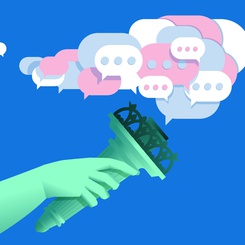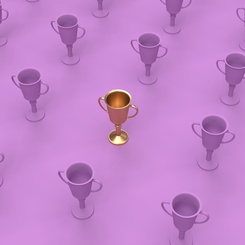With Ghalia Shamayleh
Julia Smith, editor-in-chief of ESSEC Knowledge: Hello, everyone, and welcome to Be in the Know, the ESSEC Knowledge podcast sharing the research and expertise of ESSEC professors. Today, I'm here with Ghalia Shamayleh, Assistant Professor of Marketing. Ghalia is here to talk to us about some very important research: on how sharing cute animal content is good for us. To get things started, can you tell us a bit about what led to this research?
Ghalia Shamayleh, Assistant Professor of Marketing: Sure! Thank you for having me. I'm really happy and excited to talk about this. The way that this started was during my master's research for my thesis itself. At the time, I had no idea what my topic was going to be about, but I knew that I wanted my professor, at the time, Professor Zeynep Arsel, who teaches at Concordia University and the University of Bath as well—I wanted her to follow my cat account on social media, on Instagram.
I was managing my own cat’s account at the time. When I told her about that, like I said, I had no idea what my thesis topic was gonna be, but she proposed that it would be about this specific phenomenon of cat accounts on social media. And so that was the very exciting way that we thought of that topic and how this all came about.
Julia Smith: Love that. So, what kind of research questions were you exploring with your study?
Ghalia Shamayleh: Upon revising the research a million times, which is what happens during the review process, the final research revolved around how digital objects—specifically online content on social media—are created, consumed, and circulated within digital affective networks. We specifically focused on the context of companion animals on social media.
Julia Smith: Okay, very interesting. How did you go about exploring this link between cute animal content and our relationships?
Ghalia Shamayleh: Let's start with how we looked at the creation of these digital objects, or the online content. We looked at it as a process that starts with humans and their companion animals, with two types of encounters throughout the whole process that we investigated.
First, it's the corporeal affective encounters, and that's where we start with the human and the companion animal. So just imagine you as a content creator having your companion animal and your interactions with them on a daily basis. So if it's your dog, maybe you're taking them for a walk. If it's your cat, maybe you're giving them some food or playing with them. These are corporeal affective encounters. They're physical encounters with your companion animal. And they are affect-laden—so, once you do them, there is a certain arousal of feelings, positive feelings, between you and your animal within that relationship.
Once we have these encounters, as humans who are also content creators, we are inspired to create these digital objects, which are the online content of our animals. Once we're inspired to do so, we choose visual and textual cues that we use to represent our positive feelings towards our animals through posts or stories or whatever it is that we choose to create online.
Now, we move from this corporeal affective encounter to something that we call a techno-affective encounter. Once that post is out there in the digital world—on social media—people who consume this content will start with forming parasocial relationships with companion animals.
Let’s say I'm scrolling, and I find this really cute post of a husky, and I feel very emotional about it. I want to follow this animal online, and I want to form this one-sided relationship with them. They don't know who I am. The human that has the husky doesn’t know who I am, but I know who they are, and I want to continue this one-sided relationship with them, right? That’s a parasocial relationship.
When this concept started, it was tied to celebrities and it has also been tied to influencers online because that kind of relationship is one-sided. So we moved from the affect between the human and the companion species to the affect between the consumer and the companion species they don’t know. Then it moves to something between humans and other people within their network—so the people they love, the people they want to share this content with.
This is when we move into that techno-affective encounter. We see the post, and it makes us think of our friend who really loves huskies, or maybe our friend who had a similar pet, and we want to share that content with them. That helps us create a bond with them. So, this affect circulates from the initial relationship between the human and the companion animal, to humans and other humans online.
Julia Smith: In your study, you mentioned "pebbling." Can you explain this a little bit more?
Ghalia Shamayleh: Sure! This is a term that we had read online and media articles that talked about, initially, penguins. It stems from biology—specifically something penguins do to create relationships. A Gentoo penguin will find the perfect pebble to give to their mate as a token of affection.
It’s also been used in the media to refer to what we do with one another when it comes to content. When we're online, we might see a post—of an animal or something else, because our concepts are generalizable to other content as well—and it makes us think of a friend or family member. We decide, “I'm thinking of them, and I want them to know that I’m thinking of them, and I have this intimate knowledge of something they care about, and I’m going to share it with them”. That is what we term digital pebbling: sharing a token of affection in the form of online content with our friends.
Julia Smith: So basically, spending time on our phones—so long as we’re sending something cute to our friends—could actually be good for us?
Ghalia Shamayleh: 100%. As long as you are strengthening your relationships.
Julia Smith: That’s great. So what else do you think this could mean for how we approach our relationships in this digital age?
Ghalia Shamayleh: Given the different concepts we’ve thought of and theorized, I think it’s important to understand that the positivity we gather from content can go from something as specific as the relationship between one human and their companion animal to something as generalizable as memes.
You might have come across the hippo from the Thai zoo, Moo Deng. I think that the zookeeper who posted about her just wanted to share an image of Moo Deng on social media. Now, the positivity from that post has turned into a worldwide meme phenomenon and has moved beyond its initial context.
This is another concept in our paper: decontextualization. We move from the specific situation of Moo Deng at the zoo to a decontextualized meme—like her biting the knee of one of her zookeepers, and the text there could be “Mondays.” It becomes culturally broad, stripped of the specificity, positive, and no longer solely tied to the original context.
Julia Smith: Do you think this is unique to digital content? Does it matter how people view and receive cute content?
Ghalia Shamayleh: I don’t think it’s limited to digital content. This stems from a physical interaction between a human and an animal—something we’ve been doing for ages.
Think about walking your dog in your neighborhood. You’re more likely to make friends because your dog is there. Animals are known as social lubricants—they help facilitate friendships and interactions. This behavior has now expanded into the digital world. If we focus specifically on animals, we can say their social lubricant capacities have moved beyond the physical into the digital, which I’ve always been fascinated by. I’m happy to research this, as a cat person and an animal lover in general, so I am happy to know that this extends to the digital world.
Julia Smith: Yes, it’s so interesting—and I can tell you it was a true pleasure reading your article and seeing all the cute animal photos you included. If we think beyond animal photos, I think you mentioned that this could extend to other types of content, too. What do you think the criteria are for nurturing this type of affective encounter?
Ghalia Shamayleh: Right. So we talk about that dichotomy of corporeal affective encounters and techno-affective encounters. The tie-in is the affect. As long as the corporeal-affective encounter has feelings, has affect, you can move from the physical to the digital. If there are feelings involved, people can consume and circulate that content.
Thinking of other examples, a simple example: a makeup influencer who’s passionate about makeup and is talking about a lip liner, whether or not they’re sponsoring it, on their account. You can see the effort and emotion they put into it. That starts as a corporeal affective encounter and moves into digital content. So, as long as there’s affect and something to be consumed at the other end, it can go beyond the physical.
Julia Smith: Outside of the positive implications for interpersonal relationships, what else might this mean? Do you think there are implications for the workplace or marketing professionals?
Ghalia Shamayleh: Yes, for sure. To tag on to the example of the makeup influencer, this is transferable to influencers in general. This is the world of marketing through influencers and having them sponsor your product. As a company, you need to know what drives affect and what drives these techno-affective encounters and what creates that fervor, that excitement about your product. This way, you can help partner influencers create content that resonates and consider this in influencer marketing. That understanding is crucial to making marketing campaigns effective.
Julia Smith: Before we sign off, are there any other key takeaways you want to mention from your study?
Ghalia Shamayleh: Sure! This is something I’ve thought a lot about and this is in our transferability section, but it's interesting to think beyond animals - if we think about other beings.
Consider family influencers. Many people out there listening may have come across families online who promote products or showcase their activities as a family. It's interesting to think about the children in that situation. Their parents are controlling this, and managing the accounts, and I wonder—beyond a certain age—will the children feel like they never really consented to this content? It’s funny to see it for animals, who don’t have the capacity to consent—but from what we see, if the content is positive and there is no cruelty to the animal, I like to think they’d consent to it.
Julia Smith: I think they would be happy to know they are spreading joy! It’s definitely a treat to read about positive research in a world full of negative news. I think I’m going to go look at some cute animal Instagram accounts now. Thank you so much for joining us today, Ghalia.
Ghalia Shamayleh: Thanks for having me.
Reference
Shamayleh, G., & Arsel, Z. (2025). Digital affective encounters: The relational role of content circulation on social media. Journal of Consumer Research. https://doi.org/10.1093/jcr/ucaf023








